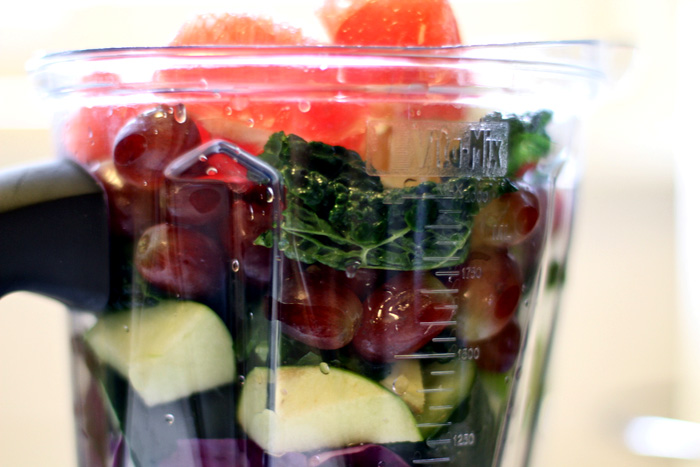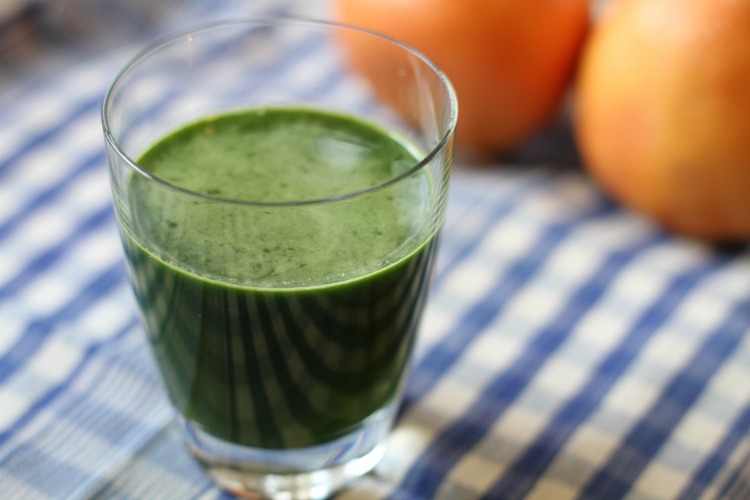One question that comes up frequently in both informal conversations and client sessions is this:
Should I get a juicer or a blender?
Of course, there are numerous lifestyle changes people can make if they want to be healthier — and many of these things don't involve buying a fancy piece of hardware.
But I think a lot of people see a juicer or blender purchase as a lifestyle change that is not only practical but symbolic as well.
They want to go all in.
So: juicer vs. blender? I have to admit — this question isn't easily answered.
It's a bit like talking to someone who's just starting to set up their home kitchen, and he or she asks, “Should I get a saute pan or a soup pot?”
It's hard for me to decide on an answer because I think once people get hooked on the healthy lifestyle, they'll eventually want both.
However, since both a juicer and a high-speed blender (i.e., Vitamix, Blendtec, etc.) are relatively expensive — which do you get first?
How do you know which machine will best suit your needs?
A Juicer Removes Fiber. A Blender Keeps it Intact.
First of all, it's important to know how the functionality of a juicer differs from a blender. Although the processing method may differ among high speed and “slow” models, a juicer basically works like this: you push produce down a tube, and the produce is processed through the machine to extract the juice and remove the pulp and fiber. When finished, the pulp has been diverted into a separate container, and you have a pitcher full of smooth, refreshing juice.
The juicing process, especially with a high-speed juicer such as a Breville, can speed oxidation and compromise the nutrients — which means you'll want to drink the juice as soon as possible to enjoy the full nutritional benefit. Slow juicers such as my Omega “vertical” model, employ a masticating method that reportedly reduces oxidation and helps preserve nutrients.

A high-speed blender, on the other hand, processes everything you put into the pitcher whole — the resulting liquid retains all of the pulp and fiber from the vegetables and fruits you've blended. You can drink the contents as is — smoothie-style — or remove the pulp by straining the liquid using a colander or nut milk bag. Leaving the pulp intact means that you'll be consuming the “whole food” with its full nutritional benefit — enzymes, vitamins and minerals, as well as dietary fiber.
Is a High Speed Blender Worth the Extra Money?
What does a high-speed blender do that a regular blender can't?
A lot.
A high-speed blender can pulverize pretty much anything that would burn out your regular blender — hard vegetables such as beets, carrots and squash, nuts, and frozen berries are processed easily.
Liquids and ice blend beautifully into a creamy consistency, and you can easily make nut milk — and even nut butters — in a blender such as the Vitamix. Or even blend up soft serve “ice cream” out of frozen fruit and a splash of liquid.
So, I say yes. It's worth it.
And if you want to save some cash, consider buying a factory reconditioned blender from Vitamix — it's a great value!
How I Utilize My Blender and Juicer
Both the juicer and the Vitamix play an important role in my efforts to maintain a healthy diet. Here's how I use them:
- Morning: Juicer — A freshly pressed green juice. This has replaced coffee as my go-to morning energy drink — far more nutritious, and no caffeine crashes. I think of green juice as a magical supplement as opposed to a full meal.
- Morning: Breakfast or Snack — I almost always have a healthy smoothie for breakfast. If I'm having a green juice that morning, then I'll likely have a smoothie for a mid-morning snack since I don't consider a juice a full meal.
- Lunch: Blender — My mid-day meal is usually a fresh salad with homemade salad dressing that I've made using the blender. Or, if I'm in a rush, I'll make another smoothie.
- Late Afternoon/Evening: Juicer — I occasionally use the juicer for an after-work pick-me-up — or a fresh juice cocktail.
- Dinner: Blender — I use the blender to puree soups, make salad dressings and blend sauces. It's also great for snacks such as hummus, dips and nut cheeses. Making nut milks and creams in a high-speed blender is a dream, something that couldn't easily be accomplished in a regular blender.
As you probably guessed, the juicer is mainly a breakfast thing for me; I simply get more “all day” use out of the blender.
However, I really treasure that morning juice — I believe the daily green juice habit has helped me ward off many a cold and bug. I enjoy the flavor of green juices and, since juice doesn't contain the naturally occurring fiber, my body doesn't have to work very hard to digest it. It's the perfect pre-workout beverage, as opposed to a smoothie, which I sometimes find a bit heavy right before a workout.
But as much as I adore my morning juice, I equally love my smoothies. Each one is packed with vitamins, lots of fresh greens, protein (nuts or seeds), some fruit, a bit of (good) fat like some avocado or almond butter, and usually a teaspoon of spirulina, chlorella or maca for good measure.
So you see, I don't like choosing between the two — I depend upon both my juicer and blender!
Try (Both) Before You Buy
I guess the best advice I can offer is for you to start by sampling some fresh juices and smoothies.
Find a health food store or restaurant near you (note: many Whole Foods locations have juice bars) and try a green juice.
The next day, try a smoothie. Maybe you'll discover that you prefer the flavor or consistency of one over the other.
Also consider your lifestyle and schedule — the juicer can require about 20-30 minutes of additional prep and cleaning. Juicing also requires a lot of produce and therefore, more budget and time at the market.
Are you currently trying to decide between a juicer and a blender? If you have any specific questions, please post a comment below — I'd love to hear from you!
In the meantime, I'm including a recipe for one of my favorites — my spicy mango smoothie.

Spicy Mango Smoothie (Serves 2)
- 1 cup of nut milk (homemade or store-bought)
- 1 cup of filtered water
- 2 gi-normous handfuls of washed spinach
- 6 tablespoons of shelled hemp seeds (easily found at Whole Foods and other natural grocers)
- About 1 1/2 cups frozen mango chunks
- 1/4 avocado or 1-2 tablespoons raw almond butter
- 1/4 to 1/2 teaspoon cayenne pepper
- 1-2 teaspoons spirulina or chlorella powder (optional)
Place all ingredients into high-speed blender and process until smooth and creamy. Serve immediately or store in the fridge to enjoy later. Salud!



